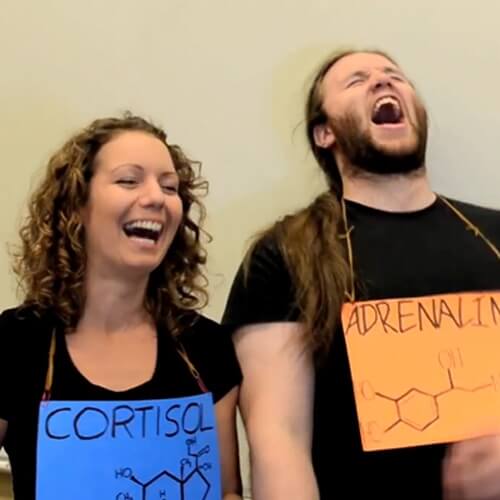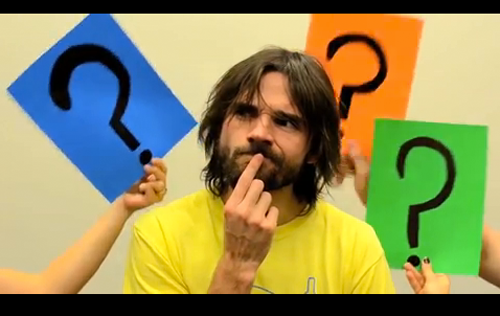News
Raluca Ellis as "cortisol" and Nigel Morton as "adrenaline."
A two-minute video written by Raluca Ellis, a postdoctoral fellow at the Harvard School of Engineering and Applied Sciences (SEAS), has won the Scientific American "Iron Egghead" video contest.
The lively, quirky video explains the role of cortisol, adrenaline, and noradrenaline in the human body. The judges praised it for its humor, attention to detail, and snappy editing.
"I just really love doing this type of work," said Ellis. "I'm very interested in science education and science communication. A lot of science videos are very serious, as if we can't also have fun."
Teaming up with her husband, Mike Ellis, and their friends Jason Lee, Dorea Reeser, and Nigel Morton, Ellis decided to take on the magazine's challenge to "explain a part, process or system of the human body in two minutes or less" while incorporating seven everyday objects.
"We decided to pick the adrenal glands because it’s something everyone has an interest in, because it’s related to stress, the fight-or-flight response, fear, and all these interesting emotions," Ellis said. "The way [the system] gets stimulated is very interesting, as well as what it makes you do."
If covering the anatomy, neurochemistry, behavior, and medical aspects of the adrenal system in just two minutes was not difficult enough (the team spent eight hours filming the video, and far longer editing it down), perhaps the real challenge lay in finding creative ways to include the required string, paper, pens, rubber bands, paper clips, cups, and balls.
"The rubber bands were a little bit tricky to incorporate," Ellis admitted.
A member of SEAS' Atmospheric Chemistry Modeling Group (led by Daniel Jacob, Vasco McCoy Family Professor of Atmospheric Chemistry and Environmental Engineering), Ellis is an environmental chemist by training. In researching the adrenal glands for the video, she learned a couple of things herself:
"All the things I’m feeling when I’m giving talks and presentations—that’s my adrenal glands. I try to tell myself now, 'Calm down, this is not a life or death situation.' We wanted to bring that aspect into the presentation too, to let people know that everyday stress can really harm your system."
Scientific American announced the winner on January 16, 2013.
"I really enjoyed the adrenal gland video," contest judge Kirsten “Kiki” Sandford told the magazine. "It had all the hallmarks of a great video: short, to the point, well-edited and produced, good sound, great use of props and people, [and] it was entertaining and educational."
"I would love to watch more videos produced by this team,” Sandford added.
Cutting-edge science delivered direct to your inbox.
Join the Harvard SEAS mailing list.

